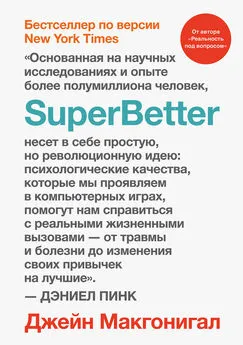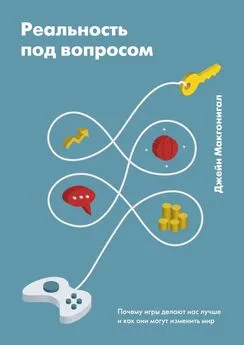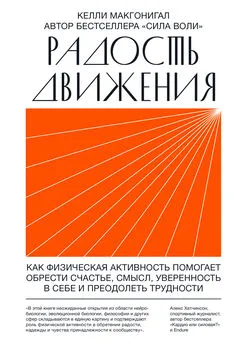Джейн Макгонигал - SuperBetter
- Название:SuperBetter
- Автор:
- Жанр:
- Издательство:Манн, Иванов и Фербер
- Год:2018
- Город:Москва
- ISBN:9785001174301
- Рейтинг:
- Избранное:Добавить в избранное
-
Отзывы:
-
Ваша оценка:
Джейн Макгонигал - SuperBetter краткое содержание
Книга будет интересна всем, кто готов освоить игровой подход для решения повседневных задач.
SuperBetter - читать онлайн бесплатно полную версию (весь текст целиком)
Интервал:
Закладка:
212
Julie M. Fritz, Steven Z. George, Anthony Delitto . The Role of Fear-Avoidance Beliefs in Acute Low Back Pain: Relationships with Current and Future Disability and Work Status // Pain. 2001. № 94 (1). P. 7–15; Gordon Waddell et al. A Fear-Avoidance Beliefs Questionnaire (FABQ) and the Role of Fear-Avoidance Beliefs in Chronic Low Back Pain and Disability // Pain. 1993. № 52 (2). P. 157–168; Maaike Leeuw et al. The Fear-Avoidance Model of Musculoskeletal Pain: Current State of Scientific Evidence // Journal of Behavioral Medicine. 2007. № 30 (1). P. 77–94; Steve R. Woby et al. Are Changes in Fear-Avoidance Beliefs, Catastrophizing, and Appraisals of Control Predictive of Changes in Chronic Low Back Pain and Disability? // European Journal of Pain. 2004. № 8 (3). P. 201–210.
213
G. Lorimer Moseley . A New Direction for the Fear Avoidance Model? // Pain. 2011. № 152 (11). P. 2447–2448.
214
Baltasar Rodero et al. Relationship Between Behavioural Coping Strategies and Acceptance in Patients with Fibromyalgia Syndrome: Elucidating Targets of Interventions // BMC Musculoskeletal Disorders. 2001. № 12 (1). 143 p.; Lance M. McCracken, Edmund Keogh . Acceptance, Mindfulness, and Values-Based Action May Counteract Fear and Avoidance of Emotions in Chronic Pain: An Analysis of Anxiety Sensitivity // Journal of Pain. 2009. № 10 (4). P. 408–415; Rikard K. Wicksell et al. A voidance and Cognitive Fusion — Central Components in Pain Related Disability? Development and Preliminary Validation of the Psychological Inflexibility in Pain Scale (PIPS) // European Journal of Pain. 2008. № 12 (4). P. 491–500; Brjánn Ljótsson et al. E xposure and Mindfulness Based Therapy for Irritable Bowel Syndrome — An Open Pilot Study // Journal of Behavior Therapy and Experimental Psychiatry. 2010. № 41 (3). P. 185–190; Paul R. Martin, Colin MacLeod. Behavioral Management of Headache Triggers: Avoidance of Triggers Is an Inadequate Strategy // Clinical Psychology Review. 2009. № 29 (6). P. 483–495; Christine Chiros, William H. O’Brien . Acceptance, Appraisals, and Coping in Relation to Migraine Headache: An Evaluation of Interrelationships Using Daily Diary Methods // Journal of Behavioral Medicine. 2011. № 34 (4). P. 307–320.
215
Measuring Experiential Avoidance . Steven C. Hayes, Richard T. Bissett, Jacqueline Pistorello, Dosheen T. Cook, University of Nevada, Reno; Kirk Strosahl , Mountainview Consulting Group; Kelly G. Wilson , University of Mississippi; Melissa A. Polusny , Minneapolis VA Medical Center; Thane A. Dykstra , Trinity Services; Sonja V. Batten , Yale University School of Medicine; Sherry H. Stewart , Dalhousie University; Michael J. Zvolensky , University of Vermont; George H. Eifert , Chapman University; Frank W. Bond , Goldsmiths College, University of London; John P. Forsyth, Maria Karekla , State University of New York at Albany; Susan M. McCurry , University of Washington. См. также: Steven C. Hayes et al. Measuring Experiential Avoidance: A Preliminary Test of a Working Model // Psychological Record. 2004. № 54. P. 553–578.
216
На английском языке.
217
Центр изучения осознанности в Чикаго Integrative Health Partners использует несколько показателей психологической гибкости. Вы можете пройти опрос по ссылке http://integrativehealthpartners.org/downloads/ACTmeasures.pdf.
218
Iris W. Hung, Aparna A. Labroo . From Firm Muscles to Firm Willpower: Understanding the Role of Embodied Cognition in Self-Regulation // Journal of Consumer Research. 2011. № 37 (6). P. 1046–1064.
219
Barbara Vann, Neil Alperstein . Dream Sharing as Social Interaction // Dreaming. 2000. № 10 (2). 111 p.; Murray L. Wax . Dream Sharing as Social Practice // Dreaming. 2004. № 14 (nos. 2–3). 83 p.; Antonietta Curci, Bernard Rimé . Dreams, Emotions, and Social Sharing of Dreams // Cognition and Emotion. 2008. № 22 (1). P. 155–167; Michael Schredl, Joelle Alexandra Schawinski . Frequency of Dream Sharing: The Effects of Gender and Personality // American Journal of Psychology. 2010. № 123 (1). P. 93–101.
220
Eddie Weitzberg, Jon O. N. Lundberg . Humming Greatly Increases Nasal Nitric Oxide // American Journal of Respiratory and Critical Care Medicine. 2002. № 166 (2). P. 144–145; M. Maniscalco et al. Assessment of Nasal and Sinus Nitric Oxide Output Using Single-Breath Humming Exhalations // European Respiratory Journal. 2003. № 22 (2). P. 323–329.
221
Lysann Damisch, Barbara Stoberock, Thomas Mussweiler . Keep Your Fingers Crossed! How Superstition Improves Performance // Psychological Science. 2010. № 21 (7). P. 1014–1020.
222
Mark Muraven, Roy F. Baumeister. Self-Regulation and Depletion of Limited Resources: Does Self-Control Resemble a Muscle? // Psychological Bulletin. 2000. № 126 (2). 247 p.
223
Steven C. Hayes, Kirk D. Strosahl , eds. A Practical Guide to Acceptance and Commitment Therapy. Springer, 2004. n. p.
224
Steven C. Hayes et al. Acceptance and Commitment Therapy: Model, Processes and Outcomes // Behaviour Research and Therapy. 2006. № 44 (1). P. 1–25; Lance M. McCracken . Committed Action: An Application of the Psychological Flexibility Model to Activity Patterns in Chronic Pain // Journal of Pain. 2013. № 14 (8). P. 828–835.
225
Термин, обозначающий верования, такие как вера в Бога или вера в научные теории, которые являются не просто равными среди других, но контролируют многие другие верования. Они влияют на выбор теорий, на вопросы, на поведение человека. Прим. ред.
226
Barry J. Zimmerman, Dale H. Schunk . Competence and Control Beliefs: Distinguishing the Means and Ends / in Patricia A. Alexander and Philip H. Winne, eds. Handbook of Educational Psychology. New York: Routledge, 2006. P. 349–367; Philip R. Magaletta, J. M. Oliver . The Hope Construct, Will, and Ways: Their Relations with Self-Efficacy, Optimism, and General WellBeing // Journal of Clinical Psychology. 1999. № 55 (5). P. 539–551; James Carifio, Lauren Rhodes . Construct Validities and the Empirical Relationships Between Optimism, Hope, Self-Efficacy, and Locus of Control // Work: A Journal of Prevention, Assessment and Rehabilitation. 2002. № 19 (2). P. 125–136; Cecil Robinson, Karla Snipes . Hope, Optimism and Self-Efficacy: A System of Competence and Control // Multiple Linear Regression Viewpoints. 2009. № 35 (2). P. 16–26.
227
C. Richard Snyder , ed., Handbook of Hope: Theory, Measures, and Applications. New York: Academic Press, 2000.
228
Sonja Lyubomirsky, Laura King, Ed Diener . The Benefits of Frequent Positive Affect: Does Happiness Lead to Success? // Psychological Bulletin. 2005. № 135 (6). 803 p.
229
Albert Bandura . Self-Efficacy: Toward a Unifying Theory of Behavioral Change // Psychological Review. 1997. № 84 (2). 191 p.
230
Идею действий на основе ценностей или «целенаправленных» действий впервые описали Стивен Хайес, Кирк Строзал и Келли Уилсон. Steven C. Hayes, Kirk D. Strosahl, Kelly G. Wilson . Acceptance and Commitment Therapy: An Experiential Approach to Behavior Change. New York: Guilford, 1999. Обзор исследований эффективности см. здесь: Francisco J. Ruiz. A Review of Acceptance and Commitment Therapy (ACT) Empirical Evidence: Correlational, Experimental Psychopathology, Component and Outcome Studies // International Journal of Psychology and Psychological Therapy. 2010. № 10 (1). P. 125–162.
231
Kelly G. Wilson et al. The Valued Living Questionnaire: Defining and Measuring Valued Action Within a Behavioral Framework // Psychological Record. 2011. № 60 (2). 4 p.
232
Russ Harris. ACT Made Simple: An Easy-to-Read Primer on Acceptance and Commitment Therapy. Oakland, CA: New Harbinger Publications, 2009. Если вам хочется пройти больше заданий для проверки своих ценностей, вы также можете посетить сайт доктора Хэрриса: www.thehappinesstrap.com.
233
www.thehappinesstrap.com.
234
www.thehappinesstrap.com.
235
То, что вам кажется простым и очевидным, может быть слишком сложным для других, и наоборот. Возможно, больше смысла для вас будет иметь задание «Пройти один километр как можно быстрее» или «Пройти один квартал как можно быстрее». Главное в хорошем задании — убедиться, что вы настроены оптимистично и способны выполнить его независимо от силы, навыков и ресурсов. Задания должны настроить вас на успех. Прим. автора.
236
Фрейминг (от англ. frame — рамка) — хорошо известное психологическое явление. Эффект фрейминга — контекст, который используется для объяснения задачи, идеи, вопроса. Обрамление сильно влияет на интерпретацию и выводы.
237
www.thehappinesstrap.com. См. также: Russ Harris. The Happiness Trap: Stop Struggling, Start Living. Auckland, NZ: Exisle Publishing, 2007.
238
Edward L. Deci, Richard Koestner, Richard M. Ryan . A Meta-Analytic Review of Experiments Examining the Effects of Extrinsic Rewards on Intrinsic Motivation // Psychological Bulletin. 1999. № 125 (6). 627 p.
239
Частный католический университет в Чикаго.
240
Университет Западного резерва — один из ведущих исследовательских центров США.
241
Carolina O. C. Werle, Brian Wansink, Collin R. Payne . Is It Fun or Exercise? The Framing of Physical Activity Biases Subsequent Snacking // Marketing Letters. 2014. P. 1–12.
Читать дальшеИнтервал:
Закладка:








